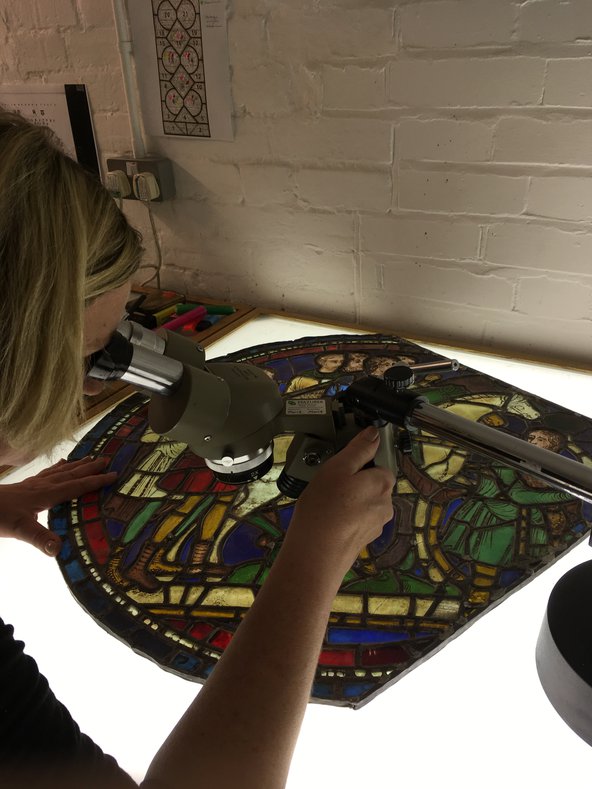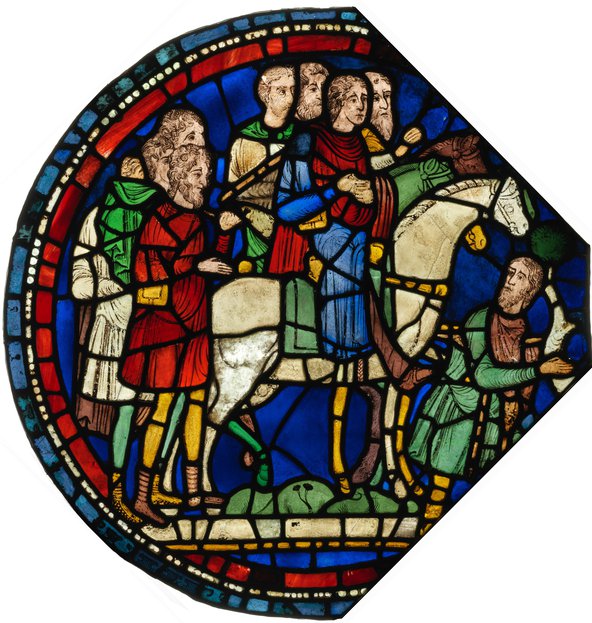Programme: Visiting Fellowships 2018
Award holder: Professor Rachel Koopmans, York University, Canada
Project title: The Thomas Becket ‘Miracle Windows’ of Canterbury Cathedral
Value: £32,902.50
Country of focus: UK
A British Academy-funded project has revised the history of Canterbury Cathedral’s stained-glass windows.

In July 2018, conservation experts at Canterbury Cathedral in the UK removed the stained-glass panels from one of the "miracle windows" overlooking the former site of Thomas Becket’s shrine. Becket, Archbishop of Canterbury from 1162 until his death in 1170, resisted King Henry II’s attempts to exert royal authority over the church. His brutal murder and subsequent fame throughout Europe has made him a key medieval figure in British history. Professor Rachel Koopmans, a medieval historian, and Leonie Seliger, head of Canterbury’s conservation studio, painstakingly examined every single piece of glass within the removed panels, thousands in all. Their work revealed that two of the window’s panels, which until then had been thought to have been made and installed in the late 19th century, were instead medieval creations dating to the mid-1180s, around 15 years after Becket was killed.

Canterbury Cathedral’s medieval stained glass is the oldest to survive in England. The ‘miracle windows’ have special historical significance as they picture the illnesses, accidents and marvellous recoveries of ordinary men, women and children that were attributed to Becket’s powers. They are by far the greatest surviving storehouse of imagery picturing pilgrims from the late Middle Ages, and were clearly intended to be viewed by visitors to Canterbury: the glass hangs low in the wall surrounding Becket’s shrine, acting much like billboards around a pilgrimage "superhighway".
The window examined with the support of the British Academy was designed to showcase the earliest events and miracles in Becket’s cult. The first of the two panels that were proved to be medieval pictures of pilgrims on the road to Canterbury – the earliest known depiction of the subject. The elite horseback riders, the ordinary walking pilgrims and the man on crutches are forerunners of the hundreds of thousands of pilgrims who would travel to Canterbury from across Europe. Remarkably, Canterbury’s glaziers made this marvellously evocative image some two centuries before Chaucer wrote the Canterbury Tales. The second panel shows pilgrims within the cathedral queueing up to receive a measure of the famous "Canterbury water", into which a tiny amount of the dead Becket’s blood was reputedly mixed. Desire for the "Canterbury water" drove much of the early popularity of the Becket cult, where following his canonisation he became one of the most celebrated saints of the Middle Ages. This newly discovered image is unique in the historical record.
As a result of this research, we now have a much more comprehensive grasp of the iconography of Canterbury’s "miracle windows", and of what the windows’ designers and patrons – the cathedral monks – hoped to convey to pilgrims. The study of this glass has and will continue to transform understanding of the narrative content of these windows, the pilgrims’ experience at Becket’s shrine, the medieval use of popular propaganda and the history of stained glass, including the history of its restoration.

At Canterbury Cathedral, there are plans to make changes to the visitor experience and to revise the curriculum for school groups as a result of these recent discoveries. The panel picturing pilgrims on the road to Canterbury has the potential to become an iconic image of the cathedral and, given how few images of travelling pilgrims have survived from the late 12th century anywhere in the world, of medieval pilgrimage in general.
Images reproduced by kind permission of the Chapter of Canterbury Cathedral.